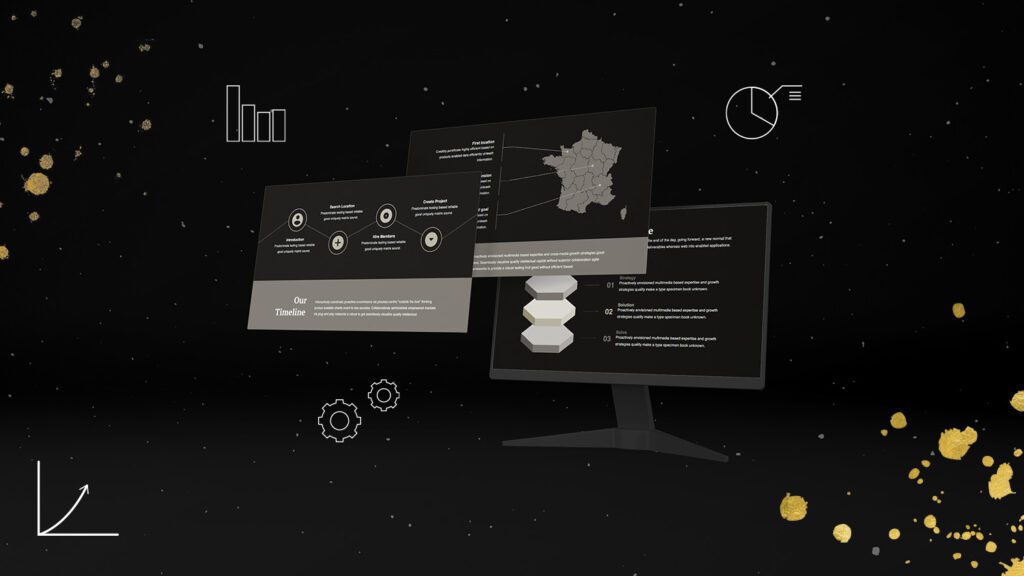Why a Powerful Pitch Deck Is Important
Building a consumer packaged goods (CPG) brand requires more than just a good product. You need a pitch deck that outlines your brand, your offerings, and why they are important if you want to partner with agencies, raise money, or land retail deals.
Making a pitch deck is often the first step toward landing a significant opportunity. A CPG pitch deck should be audience-specific, strategic, and well-crafted.
3 Types of CPG Pitch Decks You Should Know
Before creating a pitch deck, you need to know who it’s for. Not every audience wants the same information. So, here are the 3 types of pitch decks.
- Investor Pitch Deck: The purpose of an investor pitch deck is to raise capital. It should emphasize your growth strategy, market opportunity, unit economics, and traction. Sales numbers, margins, client information, and your fundraising request are all included in the investor pitch deck. Investors want to know if your company is profitable and scalable.
- Retailer Pitch Deck: Use this pitch deck when presenting your goods to supermarket chains, upscale stores, or internet marketplaces. Pay attention to your target market, pricing, packaging, and sales results. Retailers are interested in how soon your goods will be sold.
- Brand/Marketing Deck: When making a pitch to internal teams, partners, or creative agencies, use the brand/marketing deck. It focuses on the marketing plan, visual identity, and mission of your brand.
10 Essentials your CPG Pitch Deck Needs
Creating a pitch deck isn’t just about filling in slide templates, it’s about telling a clear and convincing story that proves your brand is worth the investment or shelf space. Below are the 10 key elements every CPG pitch deck should include.
1. Your Brand in One Line
Start with one strong and clear sentence that tells people exactly what you do and why your brand matters. Think of it like your elevator pitch, if someone only remembers one thing about your brand, this should be it. Make it honest, direct, and easy to understand. That one line sets the tone for everything that follows.
2. The Problem You’re Solving
Is it solving a problem no one else has figured out? Maybe you’re making snacks without fake ingredients that still taste great, or a sugar-free drink that people actually enjoy.
Get straight to the point, what’s already out there, what’s missing, and how you’re making it better. If you can sum that up in one or two simple sentences, you’re heading in the right direction.
3. Market Opportunity
Investors and retailers want to see that your brand has room to grow. Include relevant data about market trends, total addressable market (TAM), and consumer behavior shifts.
Here is a checklist of what to include:
|
Market Stat |
Why It Matters |
| Category Size |
Shows how big the opportunity is |
|
Growth Rate |
Indicates momentum |
| Competitive Positioning |
Clarifies your niche |
|
Consumer Trends |
Supports your relevance |
4. Why Your Product Stands Out
What makes your product the one that consumers should care about in a crowded market?
This is where the features of your product, the character of your brand, and the general atmosphere must all complement one another.
Think about how Magic Spoon did it, they brought back the joy of childhood cereal but made it high-protein and low-carb, all wrapped up in fun and nostalgic packaging. It hit both the emotional and health-conscious sides of their audience.
When your pitch deck clearly shows what makes your product special, it’s not just easier to grab consumers’ attention, but it makes it easier for people to say, “I want that.”
5. Social Proof and Traction
Creating a pitch deck that includes proof of traction shows you’re not just a concept, but this is strong proof that you’re a growing brand.
Nothing builds confidence like results. Use social proof and traction to showcase metrics that prove demand, revenue growth, reorder rates, retail wins, or social engagement.
You can also add things like:
- Press mentions (like “Featured in Bon Appétit”)
- Real customer reviews or influencer shoutouts
- Key numbers—think customer acquisition cost (CAC), lifetime value (LTV), or conversion rates
Need a clearer picture of what investors or stakeholders look for? Check out this breakdown of how to demonstrate traction.
6. Competitive Landscape
Investors and retail buyers want to see that you’ve done your homework.
Creating a pitch deck that clearly maps your competitive positioning shows you’re realistic and prepared. Use a simple 2×2 matrix, a feature comparison table, or a visual brand map to make your point clear.
Let’s say you’re a plant-based snack brand. You might compare your product to others based on:
- Price point
- Ingredient quality
- Brand voice or packaging appeal
- Distribution channels
7. Marketing & Promotion Strategy
Even great products need a solid go-to-market plan to succeed. Your marketing and promotion strategy should clearly explain how you’ll attract customers and generate sales.
This includes outlining your promotional mix, such as in-store activities like tastings or demos, influencer partnerships, digital advertising or SEO tactics, PR efforts, and social media engagement.
Including this in your pitch deck shows you have a smart plan to grow beyond just early supporters. It proves you’re not leaving things to chance, you’ve carefully planned how to get noticed and turn that attention into sales.
8. Key Financials
This is the part where the numbers really count. Investors will zoom in here and so will retailers because they need to know if your business can keep up with demand and stay profitable.
Your financial section should clearly show:
- Revenue to date (and YoY growth, if you have it)
- Cost of goods sold (COGS) and gross margin
- Customer acquisition cost (CAC)
- Lifetime value (LTV)
- A 12–24 month forecast with realistic projections
Make it clean and easy to understand. Just show that you know your financials and have a clear plan. According to HubSpot, what matters most is presenting numbers that are both realistic and tied to a clear growth strategy.
9. Ask What You Need and Explain Why
Don’t make people guess. If you’re raising money, say exactly how much and what it’s for, whether that’s inventory, hiring, marketing, or something else. If you’re looking for a retail placement, be clear about what kind of support you’ll need to make it work.
Being specific shows that you’ve done the math and have a plan. It tells decision-makers you’re serious, focused, and worth their attention.
Creating a pitch deck without a clear question? That’s like giving someone a map with no destination. Most won’t take the time to follow up, they’ll just move on.
10. Your Brand’s Closing Slide
Wrap it up with a slide that’s simple but memorable. Think of it as your final handshake.
Include your logo, a short tagline, and your contact info. Then add one last line that ties back to your mission, something that reminds people why your brand exists and what you stand for.
This isn’t the place to cram in more info. It’s your chance to leave a strong impression. Be confident, polished, and totally on-brand.
Make Your Pitch Deck Work for You
Creating a pitch deck isn’t a one-time task, it’s a living tool that evolves as your business grows. Use it to open doors, spark conversations, and lead to real results.
If you’re unsure where to start or want your deck to look as good as your product tastes, we can help. From design to messaging, we’ve helped CPG brands go from idea to shelf-ready.
👉 Explore our creative services or contact MAVRK Studio to get pitch-ready today.





